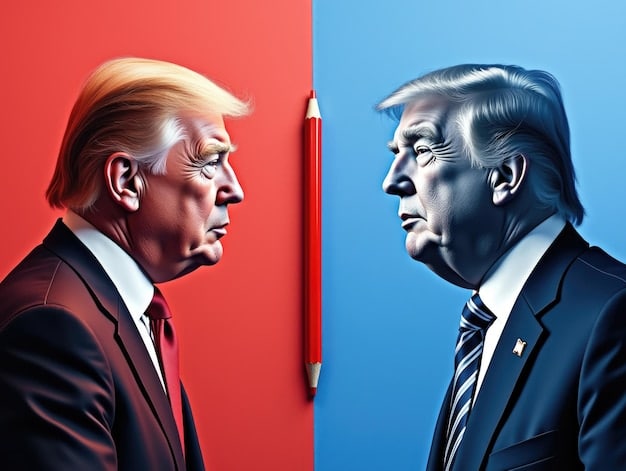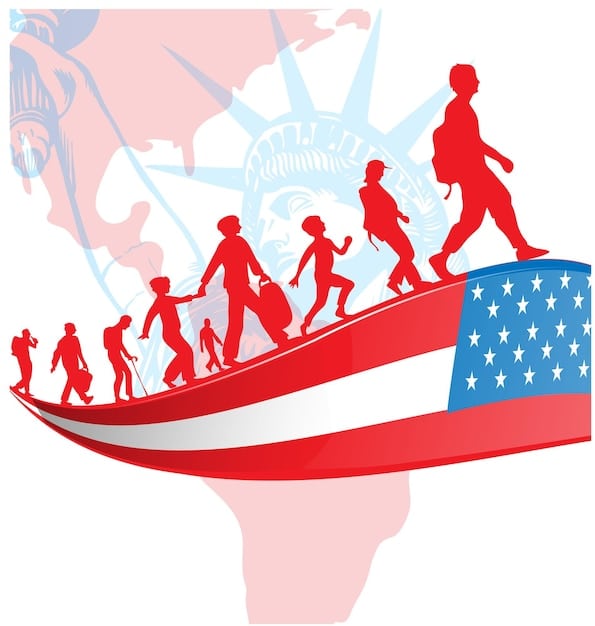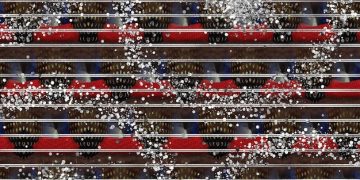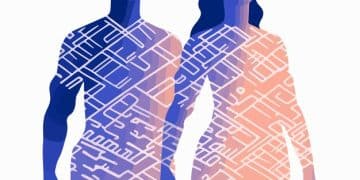Social Identity Theory: Explaining US Political Tribalism

Social Identity Theory illuminates the escalating tribalism in US politics by positing that individuals derive self-esteem from group affiliation, leading to ingroup favoritism, outgroup derogation, and heightened polarization when political identities become central to one’s self-concept.
The landscape of US politics has undeniably shifted, giving rise to an increasingly polarized environment often characterized by strong group loyalties and animosity towards opposing factions. Understanding how does social identity theory explain the rise of tribalism in US politics offers a nuanced perspective on this phenomenon, moving beyond mere ideological differences to explore the deep psychological underpinnings of group affiliation and conflict. This theory provides a framework for comprehending why political identities have become so central to self-perception and how this contributes to the current state of division.
The Foundations of Social Identity Theory
Social Identity Theory (SIT), developed by Henri Tajfel and John Turner, provides a powerful lens through which to examine intergroup relations, including the dynamics observed in modern US politics. At its core, SIT posits that individuals strive to achieve or maintain a positive self-concept, and this self-esteem is derived, in part, from the groups they belong to. When group membership becomes a salient aspect of an individual’s identity, their self-worth is intrinsically linked to the perceived status and distinctiveness of that group.
This psychological need for a positive social identity drives several key processes. Firstly, people tend to categorize themselves and others into various social groups, such as political parties, sports teams, or national identities. Once categorized, an individual’s perception of their ingroup (the group they belong to) becomes more favorable, while their perception of outgroups (groups they do not belong to) may become less so. This cognitive bias, known as ingroup favoritism, is a fundamental component of SIT, leading individuals to evaluate their own group as superior in various dimensions.
Ingroup Favoritism and Outgroup Derogation
The tendency to favor one’s own group, even when based on arbitrary distinctions, is well-documented in social psychology. This ingroup favoritism often extends to an active derogation of outgroups, where members of opposing groups are viewed more negatively, stereotyped, and subjected to prejudice. In the political sphere, this translates into partisan loyalty that transcends policy agreements, where identifying as a Democrat or Republican becomes a core aspect of personal identity, leading to the devaluation of those on the other side.
This dynamic is exacerbated when the ingroup perceives its distinctiveness as threatened by an outgroup. In such scenarios, group boundaries become more rigid, and individuals may adhere more strictly to ingroup norms and values, often at the expense of intergroup cooperation. The political narrative often frames the “other” side as an existential threat, further solidifying ingroup cohesion and justifying negative perceptions of the outgroup.
- Categorization: People classify themselves and others into social groups.
- Identification: Individuals identify with their ingroup, adopting its norms and values.
- Comparison: Groups compare themselves to outgroups, often in ways that enhance ingroup status.
- Distinctiveness: Groups strive for positive distinctiveness from outgroups.
The political environment in the US, with its two dominant parties, provides a fertile ground for these SIT processes to flourish. The strong partisan divide, often fueled by media narratives and political rhetoric, reinforces ingroup identification and outgroup derogation, effectively creating political “tribes” that define themselves as much by who they are not as by who they are.
The Evolution of Political Identity and Tribalism
The historical trajectory of US politics has seen a gradual intensification of political identity, moving beyond mere policy preferences to encompass deeply held moral and social values. This evolution has transformed political affiliation from a pragmatic choice to a fundamental aspect of self-identity for many Americans. When an individual’s political identity becomes inextricably linked to their personal identity, the stakes of political outcomes are raised significantly. Defeat for one’s political party is no longer just a policy setback; it can feel like a personal affront or a threat to one’s social standing.
This hardening of political identity is a critical factor in understanding tribalism. The stronger the identification with a political group, the greater the tendency to dismiss or demonize opposing viewpoints. This is not simply about disagreeing on the best economic policy; it is about protecting and affirming one’s group’s values, norms, and perceived superiority. The emotional investment in political outcomes becomes immense, leading to greater resistance to compromise and a heightened sense of intergroup conflict.
From Ideology to Identity: The Deepening Divide
Historically, political parties were often more diverse ideologically, with greater overlap between moderates from both sides. However, in recent decades, there has been a considerable movement towards ideological purity within each major party. This “sorting” of ideologies has made political identity more consistent and predictable, consolidating group boundaries and reducing the likelihood of cross-cutting identities that might bridge divides. As political parties become more ideologically homogenous, the ingroup feels more cohesive, and the outgroup appears more alien.
The rise of social media and fragmented news consumption has further amplified this trend. Individuals can self-select into information silos that reinforce their existing beliefs and ingroup narratives, leading to an echo chamber effect. This lack of exposure to diverse perspectives entrenches biases and strengthens the perception of the outgroup as uniformly hostile or misguided. The absence of shared understanding or common ground prevents the empathy and commonality necessary for constructive political discourse.
- Ideological Sorting: Parties become more ideologically distinct, reinforcing group boundaries.
- Self-Selection: Individuals gravitate towards like-minded peers and information sources.
- Echo Chambers: Limited exposure to diverse viewpoints entrenches existing beliefs.
- Emotional Investment: Political outcomes become deeply personal, increasing stakes.
The transformation of political affiliation into an integral part of personal identity is not merely a political phenomenon; it is a profound psychological shift that Social Identity Theory is uniquely positioned to explain. It highlights how the human need for belonging and positive self-regard can manifest in polarized political systems, influencing everything from voting behavior to everyday social interactions. Understanding this link is crucial for addressing the growing tribalism.
The Role of Threat Perception and Group Cohesion
A key dynamic within Social Identity Theory that profoundly influences political tribalism is the interplay between perceived external threats and internal group cohesion. When a political group perceives an outgroup as a significant threat—whether to its values, way of life, economic prosperity, or even its demographic composition—ingroup loyalty and solidarity tend to increase dramatically. This phenomenon is often exploited by political leaders who can galvanize their base by articulating a clear “us vs. them” narrative.
The perception of threat can come in various forms. It might be framed as an economic threat, where one party blames the other for national financial woes. It could be a cultural or moral threat, where one side accuses the other of undermining traditional values. Or, it might be an existential threat to democratic institutions themselves. Regardless of its specific nature, a perceived threat strengthens the psychological boundaries between groups, making cooperation more difficult and conflict more likely. This heightened sense of danger inhibits the ability to find common ground or compromise.

Amplifying Divides: Media and Political Rhetoric
The modern media landscape, especially cable news and social media, plays a significant role in constructing and amplifying these threat perceptions. News outlets often tailor their content to appeal to specific partisan audiences, reinforcing existing biases and presenting the “other” side in a negative light. This can lead to a cycle where partisan media consumes content that validates their ingroup’s views and demonizes the outgroup, further solidifying their tribal loyalties.
Political rhetoric also capitalizes on this. Leaders and pundits often employ language that evokes fear and anger towards the opposing political faction, framing disagreements as battles between good and evil rather than differing policy approaches. This rhetoric strengthens ingroup bonds by creating a common enemy, making it easier to overlook internal disagreements within the ingroup and focus animosity outward. During election cycles, this dynamic becomes particularly acute, as campaign narratives often lean heavily on portraying the opposition as unqualified, dangerous, or immoral.
- External Threat Perception: Strengthens ingroup cohesion against a common enemy.
- Us vs. Them Narratives: Political leaders simplify complex issues into binary conflicts.
- Media Reinforcement: Partisan media validates ingroup views and demonizes outgroups.
- Rhetorical Escalation: Language of fear and anger solidifies tribal loyalties.
The mechanism of threat perception is a powerful driver of tribalism, as it appeals to fundamental human instincts for self-preservation and group protection. When these instincts are harnessed by political actors and amplified by information environments, the result is a deeply entrenched polarization where compromise is seen as weakness, and loyalty to the tribe surpasses all other considerations. SIT illuminates how this psychological process contributes significantly to the current political climate.
Consequences of Political Tribalism on Democracy
The rise of political tribalism, as understood through the lens of Social Identity Theory, carries significant implications for the functioning and health of democratic systems. When political identities become deeply ingrained and foster intense ingroup-outgroup biases, the very mechanisms of democratic governance—such as debate, compromise, and consensus-building—are severely undermined. The shift from ideological disagreements to identity-based conflicts transforms political opponents into enemies, making true bipartisan cooperation increasingly difficult.
One major consequence is gridlock. If each political “tribe” views the other as fundamentally opposed to its interests and values, then policy solutions are often rejected not on their merits, but because of their association with the opposing group. This can lead to paralysis in governance, with critical issues remaining unaddressed due to an inability to forge common ground. The focus shifts from solving national problems to winning battles against the perceived adversary, even if it means sacrificing broader public good.
Erosion of Trust and Democratic Norms
Tribalism also erodes trust, not only between political factions but also in democratic institutions themselves. When one’s political identity is paramount, and the opposing side is seen as illegitimate or dangerous, elections and institutions that do not produce desired outcomes may be viewed with suspicion. This can manifest as challenges to electoral integrity, distrust in judicial rulings, or skepticism towards government agencies. The foundation of mutual respect and shared commitment to democratic processes begins to crumble.
Moreover, politeness and civility in public discourse diminish significantly. Personal attacks, widespread disinformation, and character assassinations become common tools, further entrenching animosity. This aggressive rhetoric, constantly reinforced by partisan media, creates a hostile environment that discourages deliberation and encourages withdrawal into ideological enclaves. The very act of engaging with the “other side” becomes an act of betrayal to one’s own ingroup. The danger this poses to a functioning democracy, which relies heavily on a degree of cooperation and respect among diverse viewpoints, cannot be overstated.
- Political Gridlock: Inability to compromise due to identity-based opposition.
- Erosion of Trust: Diminished faith in institutions and electoral outcomes.
- Decline of Civility: Increased personal attacks and hostile rhetoric.
- Reduced Cooperation: Obstacles to bipartisan problem-solving.
The consequences of unchecked political tribalism extend beyond mere policy disagreements. They threaten the normative fabric of democracy, hindering its ability to adapt, deliberate, and govern effectively. Understanding these ramifications through Social Identity Theory emphasizes the urgent need to address the psychological dimensions of political division, rather than simply focusing on the ideological ones.
Strategies for Mitigating Political Tribalism
Given the pervasive influence of Social Identity Theory on political tribalism, developing strategies to mitigate these divisive forces requires a multi-faceted approach that addresses both individual psychological processes and broader societal structures. While completely eradicating group identification is neither possible nor desirable, fostering a more inclusive and cooperative political environment is crucial.
One key strategy involves promoting superordinate goals – objectives that transcend individual group interests and require intergroup cooperation for their achievement. When political factions are presented with common challenges that affect everyone (e.g., climate change, national security, economic prosperity), the focus can shift from intergroup competition to collaborative problem-solving. This can encourage the perception of a larger, shared identity (“Americans”) that encompasses and prioritizes over narrower political identities. By working together towards shared objectives, individuals may begin to see those from opposing groups more as allies than adversaries.
Intergroup Contact and Decategorization
Direct, positive intergroup contact can also be an effective strategy. When individuals from different political groups interact in non-competitive settings, particularly where they have common interests or can work towards a shared task, negative stereotypes can be challenged, and empathy can increase. This direct interaction helps to “decategorize” individuals, reducing their primary identity to that of their political group and instead seeing them as unique individuals with diverse perspectives. This humanization of the “other” is essential for breaking down tribal barriers.
Furthermore, responsible leadership and media portrayal are vital. Political leaders can choose to emphasize shared values and common ground rather than constantly highlighting differences and stoking resentment. Media outlets can commit to more balanced reporting, resisting the urge to sensationalize conflict or demonize one side. Promoting critical thinking skills among citizens, especially regarding media consumption, can also help individuals resist the allure of echo chambers and biased narratives, fostering a more nuanced understanding of complex issues.
- Superordinate Goals: Focus on shared challenges requiring intergroup cooperation.
- Intergroup Contact: Foster positive interactions between members of different political groups.
- Responsible Leadership: Emphasize common ground and shared values.
- Media Literacy: Encourage critical consumption of news and information.
Addressing political tribalism is a complex, long-term endeavor, but insights from Social Identity Theory provide actionable pathways. By understanding the psychological underpinnings of group formation and conflict, we can develop targeted interventions that encourage greater intergroup understanding, foster shared identities, and ultimately strengthen the foundations of a healthy democracy.
The Future of Political Identity in the US
Considering the profound insights offered by Social Identity Theory, the future direction of political identity in the US appears to be at a critical juncture. The forces driving tribalism are powerful, rooted in fundamental human psychology and amplified by contemporary media and political structures. However, understanding these mechanisms also offers hope for intentional mitigation and a potential shift towards more constructive forms of political engagement.
One possible trajectory is a continued deepening of partisan identities, where political groups become even more segregated, not just ideologically but socially. This could lead to further societal fragmentation, making compromise virtually impossible and potentially undermining the stability of democratic governance. In this scenario, political affiliation would continue to be a primary lens through which individuals view the world and form their social circles, leading to a perpetual state of “cold civil war.”

The Potential for Shifting Identities and Superordinate Goals
Alternatively, there is potential for a shift, perhaps driven by changing demographics, emergent national crises that demand unity, or a deliberate effort by institutions and civil society to foster shared identity. If challenges arise that are so significant they compel different political groups to unite under a common American identity—a classic example of a superordinate goal—this could provide a pathway out of extreme tribalism. Such events could highlight shared vulnerabilities and interests, encouraging a recategorization away from partisan allegiances towards a broader national identity.
Furthermore, grassroots efforts aimed at fostering dialogue, empathy, and critical media literacy could gradually contribute to a more nuanced understanding of political opponents and complex issues. Empowering individuals to recognize and challenge their own ingroup biases, and to seek out diverse perspectives, is a crucial long-term strategy for building resilience against manipulative tribalistic impulses. The cultivation of identities based on shared humanity rather than rigid political affiliation becomes a crucial endeavor.
- Continued Fragmentation: Deeper segregation and perpetual conflict.
- Emergent Unity: National crises fostering superordinate goals and shared identity.
- Grassroots Initiatives: Dialogue and empathy building across political divides.
- Media Literacy: Cultivating critical consumption and resistance to bias.
The path forward is not predetermined, but hinges on a collective willingness to understand and address the psychological roots of political division. Social Identity Theory doesn’t just explain the problem; it also points towards potential solutions by emphasizing the dynamic nature of social identities and the power of shared goals to reorient group relations. The future of US politics, therefore, may depend as much on how its citizens and leaders manage social identities as it does on policies and ideologies.
| Key Concept | Brief Description |
|---|---|
| 🧠 Social Identity | Part of self-concept derived from group membership. |
| 🤝 Ingroup Favoritism | Tendency to prefer one’s own group over others. |
| ⚔️ Outgroup Derogation | Negative evaluation or stereotyping of opposing groups. |
| 🌐 Superordinate Goals | Shared objectives that unite diverse groups towards common action. |
Frequently Asked Questions About Political Tribalism
▼
Social Identity Theory posits that individuals derive a significant part of their self-esteem from their group memberships. In politics, this means people strongly identify with their political party or ideology, leading to ingroup favoritism and a tendency to view opposing political groups negatively, which contributes to tribalism.
▼
Ingroup favoritism leads individuals to perceive their own political group as superior and to trust its members more. This natural bias can reduce willingness to compromise, cooperate, or even engage respectfully with outgroup members, solidifying partisan divides and fueling polarization within discourse.
▼
Yes, SIT suggests mitigation strategies like promoting superordinate goals that require intergroup cooperation, fostering positive intergroup contact to reduce stereotypes, and encouraging leaders and media to emphasize shared values rather than division. These actions can help reframe group boundaries and foster broader, unifying identities.
▼
Media and political rhetoric often amplify tribalism by framing issues as “us vs. them,” creating perceived threats from outgroups, and reinforcing existing biases through selective information. This content fuels fear and anger, solidifying ingroup bonds and justifying negative perceptions of the opposition, thus deepening divides.
▼
Political identity has become central due to factors like ideological sorting, where parties are more ideologically homogenous; self-selection into media echo chambers; and heightened emotional investment in political outcomes. These elements strengthen the linkage between one’s personal identity and their political affiliation, making it a core aspect of self-concept.
Conclusion
The exploration of how Social Identity Theory explains the rise of tribalism in US politics reveals a deep, psychological narrative behind the current state of polarization. It is not merely about policy disagreements or ideological differences; rather, it is fundamentally rooted in the human need for belonging and positive self-regard, which become intertwined with political group affiliations. As individuals derive increasing self-esteem from their political identities, the lines between “us” and “them” harden, leading to ingroup favoritism, outgroup derogation, and a decreased capacity for compromise. While the challenges posed by this intensified tribalism are profound, understanding its psychological underpinnings through this theory offers actionable pathways toward fostering more inclusive identities and rebuilding the foundational elements of democratic discourse and cooperation. The future trajectory of US politics may well depend on the collective endeavor to navigate these powerful social identity dynamics.





